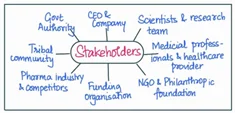Answer:
| Approach:
Introduction:
Body
- As the CEO, various actions that could be taken in this scenario
- Evaluation of pros and cons for each action
Conclusion
|
Introduction:
A scientist discovers a potential cure for an incurable liver disease prevalent in tribal areas using a bestselling veterinary drug.
The CEO faces the dilemma of whether to invest Rs. 50 crores in developing the drug variant despite limited market prospects.

Body:
(a) As the CEO, various actions that could be taken in this scenario include:
- Research Grants: Seek external research grants or funding from governmental or non-profit organizations that focus on healthcare and medical research. This could help cover the substantial R&D costs and incentivize the development of the variant of the drug.
- Collaboration or Partnership: Explore potential collaborations or partnerships with organizations, universities, or research institutions that have an interest or expertise in liver diseases or tribal healthcare. This could allow for cost-sharing and knowledge exchange, reducing the financial burden on the company.
- Government Support: Engage with government bodies and policymakers to discuss the potential public health impact of the drug variant. Advocate for financial support or subsidies for the research and development, highlighting the positive social and economic outcomes that could result from the availability of a cure for the liver disease.
- Philanthropic Initiatives: Tap into corporate social responsibility initiatives by partnering with philanthropic foundations or organizations that are focused on addressing healthcare disparities and supporting research for underserved populations. This could provide financial support or access to resources for the R&D efforts.
(b) Evaluation of pros and cons for each action:
- Research Grants:
- Pros: External funding reduces the financial burden on the company, allowing for the development of the drug variant without solely relying on the market viability. It also brings in external expertise and collaboration opportunities.
- Cons: Securing research grants can be competitive and time-consuming. It may also come with certain restrictions or conditions that could impact the company’s control over the research and future commercialization.
- Collaboration or Partnership:
- Pros: Collaboration allows for cost-sharing, knowledge exchange, and access to additional resources or expertise. It can also help build networks and relationships that may be beneficial for future projects.
- Cons: Collaborations require careful negotiation and coordination. Differences in priorities, intellectual property rights, or conflicting interests could arise, potentially impacting the progress of the project.
- Government Support:
- Pros: Government support can provide financial assistance, subsidies, or favorable regulations that can offset the R&D costs. It also highlights the company’s commitment to addressing public health challenges and strengthens its reputation.
- Cons: Government processes can be bureaucratic and time-consuming. The outcome may be uncertain, and there may be limited funding available for such specific research areas.
- Philanthropic Initiatives:
- Pros: Partnering with philanthropic organizations showcases the company’s commitment to social impact and health equity. It can provide financial support and access to resources that might not be available through traditional funding channels.
- Cons: Philanthropic initiatives may have their own agendas or areas of focus, which may not align perfectly with the company’s goals. There may be limited availability of funding or competition for support from other organizations.
Conclusion:
It is important for the CEO to carefully evaluate these actions, considering factors such as financial feasibility, potential impact on the company’s reputation, long-term sustainability, and alignment with the company’s core values and objectives.
